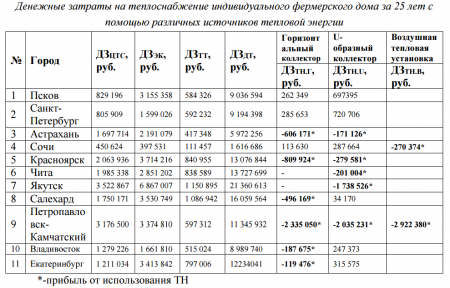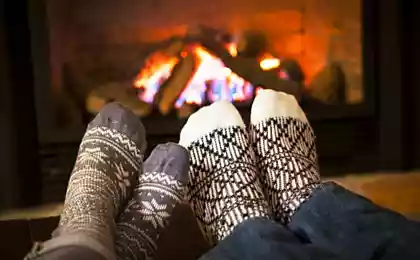606
Autonomous heat supply of the farm
Russia is the world's largest exporter of energy resources and occupies a leading position in reserves of traditional fuel and energy resources, a large part of the country is outside the centralized power supply. As shown by the following results of the analysis, the use of heat pump (HP) will help to solve the problem of heat supply of the isolated farms.
Heat pumps use the free renewable sources of energy: low-potential heat of the air, soil, groundwater and open ice-free water bodies, this fact makes possible their use in farms which are far from district heating networks. To study the effectiveness of HS on the territory of Russia selected 11 regions located near the cities of Pskov, Saint-Petersburg, Astrakhan, Sochi, Krasnoyarsk, Chita, Yakutsk, Salekhard, Petropavlovsk-Kamchatsky, Vladivostok, and Yekaterinburg.

There is a wide variety of heating installations as the primary source of heat which can be air, soil or water. The use of heat pumps with different types of reservoirs impose some sort of restrictions on their use. When using a heat pump air-water in areas with outdoor air temperature in winter months below -20°C, you must install backup heat source for the colder months. Analyzing the indicators of air temperature of the coldest five-day week in selected cities, got that only in two regions (near cities of Sochi and Petropavlovsk-Kamchatsky) the temperature does not fall below -20°C, which makes it possible to use air heat pump to cover the needs in heating of private homes in these cities.
Heat pump with ground collector can be applied only in the case that the temperature of the soil at the level of the manifold gasket does not fall below 0°C (that is, no transition of the soil in the frozen state (freezing)), even in the winter time. So in 9 cities (Pskov, Saint Petersburg, Astrakhan, Sochi, Sankt-Peterburg, Petropavlovsk-Kamchatsky, Vladivostok, Krasnoyarsk, Yekaterinburg) of the 11 analyzed have the opportunity to lay a horizontal ground heat exchanger at a depth of 1.6 m, as the depth of frost penetration of the soil located above this value.
Russia – the territory with the largest distribution of permafrost. In the area of permafrost soils is more than 60% of the country; this is mainly the territory of Central and Eastern Siberia and the Northern Far East. On the permafrost are Magadan, Anadyr, Yakutsk, Mirny, Norilsk, Igarka, Nadym, Vorkuta, on the borders of Chita there are also Islands of permafrost. The city of Yakutsk is located in the permafrost area, the ground is frozen sufficiently great depth, which makes it impossible to use a thermal system with a horizontal collector in areas with perpetual frozen and, in particular, in Yakutsk. Chitinskaya oblast has part of the territory in the permafrost where frost depth exceeds 3.2 meters, which also makes it inappropriate to use the installation with a horizontal collector in Chita oblast as a heat source for heating the room.
In the Russian market of heat pumps manufacturers, as domestic market teplonasos equipment being formed. The cheapest manufacturers of TN are such countries as China, the Czech Republic and the USA. Thermal plants produced in Germany and Sweden, are the most expensive. According to the conducted calculations, the cost of 1 kW of heat a geothermal installation from foreign manufacturers is 19 996 rubles, the cost of an air heat installation slightly exceeds this amount and is 20 505 rubles.
Comparison of cost of installing geothermal and air collectors, including the cost of transportation, installation and commissioning shows that the heat pump with a vertical ground loop is the most expensive — 102 279 rubles for 1 kW of power equipment, followed by heat pump with horizontal ground loop — 79 674 rubles. The cheapest is air teplostroy 44 383 rubles per 1 kW as heat source uses outside air and does not require additional costs for excavation of trenches, therefore, the value of TN is reduced and is determined only by the price of the pump and installation works.
The payback period (FROM) T is directly proportional to the capital cost of its installation and is inversely proportional to the monetary savings, which is equal to the cost of heating. The heat tariffs in Russian cities are very different, so the price of 1 Gcal of energy in St. Petersburg is 1050 rubles., and in Petropavlovsk-Kamchatsky — 3580 RUB (ie rates differ by 3 times).
The minimum payback period for the performed calculations can be seen in the Eastern regions of Russia, where the cost of district heating is quite high. The minimum payback period in Petropavlovsk-Kamchatsky for a geothermal pump with a horizontal loop is 7 years for thermal plant with a vertical manifold 9 years, followed by Yakutsk (Sauveur. = 13 years)) and Krasnoyarsk (Sogor. = 15 years.. = 22 years). The maximum payback period for thermal installations in Saint-Petersburg (Sogor. = 34.. = 47 years) and Pskov (Sogor.= 33.. = 46), Sochi (Sogor. = 31.. = 41).
Heating with air heat pumps is possible only in two cities out of the eleven considered, namely in Sochi and Petropavlovsk-Kamchatsky, the payback period of thermal plants in these cities are 10 years and 2 years, respectively.
The service life of the heat pump is limited only by the lifetime of the compressor as the only devices containing moving parts, the service life of which is 25 years. After this period, the compressor must be replaced. The life of the reservoir is up to 50 years. The table below presents calculations of cash costs (RS) for heating for 25 years using various sources of heat energy: district heating (JCTS); electric, solid fuel and diesel boiler (ZAK, DSTT, JDT), air heat pump (JTN.In) T with horizontal and vertical header (JTN.G, DST.U).

Most of the considered cities the payback period of thermal plants is less than its service life (25 years). This allows you to profit from 171 126 rubles (Astrakhan, when using heat setting with horizontal manifold) to 2 992 380 RUB (Petropavlovsk-Kamchatsky, when using air heat collector) for 25 years of use TN.
In the climatic conditions of Saint-Petersburg and Pskov none of the types of heat pumps doesn't pay. In this case, you should consider heating with other energy sources. The table above shows that in St. Petersburg heat pump with horizontal collector mediocubital 285 653 RUB and RUB 720 706 with a vertical collector. When compared with other sources of thermal energy the use of TN, even if the payback period more than the period of operation, is economically advantageous since the costs for 25 years (neoacademist) will be less than the cost of heating a home with other installations during the same period.
The results of calculation of efficiency of application of heat pumps, is made subject to temperature limitations (outdoor air temperature t ⩾ -20 °C and the temperature of the soil tг > 0°C) and operating life of heat pumps (25 years) indicate the feasibility and efficiency of their application in Russia. published
Author: E. A. Muravleva
P. S. And remember, only by changing their consumption — together we change the world! ©
Join us in Facebook , Vkontakte, Odnoklassniki
Source: alternativenergy.ru
Heat pumps use the free renewable sources of energy: low-potential heat of the air, soil, groundwater and open ice-free water bodies, this fact makes possible their use in farms which are far from district heating networks. To study the effectiveness of HS on the territory of Russia selected 11 regions located near the cities of Pskov, Saint-Petersburg, Astrakhan, Sochi, Krasnoyarsk, Chita, Yakutsk, Salekhard, Petropavlovsk-Kamchatsky, Vladivostok, and Yekaterinburg.

There is a wide variety of heating installations as the primary source of heat which can be air, soil or water. The use of heat pumps with different types of reservoirs impose some sort of restrictions on their use. When using a heat pump air-water in areas with outdoor air temperature in winter months below -20°C, you must install backup heat source for the colder months. Analyzing the indicators of air temperature of the coldest five-day week in selected cities, got that only in two regions (near cities of Sochi and Petropavlovsk-Kamchatsky) the temperature does not fall below -20°C, which makes it possible to use air heat pump to cover the needs in heating of private homes in these cities.
Heat pump with ground collector can be applied only in the case that the temperature of the soil at the level of the manifold gasket does not fall below 0°C (that is, no transition of the soil in the frozen state (freezing)), even in the winter time. So in 9 cities (Pskov, Saint Petersburg, Astrakhan, Sochi, Sankt-Peterburg, Petropavlovsk-Kamchatsky, Vladivostok, Krasnoyarsk, Yekaterinburg) of the 11 analyzed have the opportunity to lay a horizontal ground heat exchanger at a depth of 1.6 m, as the depth of frost penetration of the soil located above this value.
Russia – the territory with the largest distribution of permafrost. In the area of permafrost soils is more than 60% of the country; this is mainly the territory of Central and Eastern Siberia and the Northern Far East. On the permafrost are Magadan, Anadyr, Yakutsk, Mirny, Norilsk, Igarka, Nadym, Vorkuta, on the borders of Chita there are also Islands of permafrost. The city of Yakutsk is located in the permafrost area, the ground is frozen sufficiently great depth, which makes it impossible to use a thermal system with a horizontal collector in areas with perpetual frozen and, in particular, in Yakutsk. Chitinskaya oblast has part of the territory in the permafrost where frost depth exceeds 3.2 meters, which also makes it inappropriate to use the installation with a horizontal collector in Chita oblast as a heat source for heating the room.
In the Russian market of heat pumps manufacturers, as domestic market teplonasos equipment being formed. The cheapest manufacturers of TN are such countries as China, the Czech Republic and the USA. Thermal plants produced in Germany and Sweden, are the most expensive. According to the conducted calculations, the cost of 1 kW of heat a geothermal installation from foreign manufacturers is 19 996 rubles, the cost of an air heat installation slightly exceeds this amount and is 20 505 rubles.
Comparison of cost of installing geothermal and air collectors, including the cost of transportation, installation and commissioning shows that the heat pump with a vertical ground loop is the most expensive — 102 279 rubles for 1 kW of power equipment, followed by heat pump with horizontal ground loop — 79 674 rubles. The cheapest is air teplostroy 44 383 rubles per 1 kW as heat source uses outside air and does not require additional costs for excavation of trenches, therefore, the value of TN is reduced and is determined only by the price of the pump and installation works.
The payback period (FROM) T is directly proportional to the capital cost of its installation and is inversely proportional to the monetary savings, which is equal to the cost of heating. The heat tariffs in Russian cities are very different, so the price of 1 Gcal of energy in St. Petersburg is 1050 rubles., and in Petropavlovsk-Kamchatsky — 3580 RUB (ie rates differ by 3 times).
The minimum payback period for the performed calculations can be seen in the Eastern regions of Russia, where the cost of district heating is quite high. The minimum payback period in Petropavlovsk-Kamchatsky for a geothermal pump with a horizontal loop is 7 years for thermal plant with a vertical manifold 9 years, followed by Yakutsk (Sauveur. = 13 years)) and Krasnoyarsk (Sogor. = 15 years.. = 22 years). The maximum payback period for thermal installations in Saint-Petersburg (Sogor. = 34.. = 47 years) and Pskov (Sogor.= 33.. = 46), Sochi (Sogor. = 31.. = 41).
Heating with air heat pumps is possible only in two cities out of the eleven considered, namely in Sochi and Petropavlovsk-Kamchatsky, the payback period of thermal plants in these cities are 10 years and 2 years, respectively.
The service life of the heat pump is limited only by the lifetime of the compressor as the only devices containing moving parts, the service life of which is 25 years. After this period, the compressor must be replaced. The life of the reservoir is up to 50 years. The table below presents calculations of cash costs (RS) for heating for 25 years using various sources of heat energy: district heating (JCTS); electric, solid fuel and diesel boiler (ZAK, DSTT, JDT), air heat pump (JTN.In) T with horizontal and vertical header (JTN.G, DST.U).

Most of the considered cities the payback period of thermal plants is less than its service life (25 years). This allows you to profit from 171 126 rubles (Astrakhan, when using heat setting with horizontal manifold) to 2 992 380 RUB (Petropavlovsk-Kamchatsky, when using air heat collector) for 25 years of use TN.
In the climatic conditions of Saint-Petersburg and Pskov none of the types of heat pumps doesn't pay. In this case, you should consider heating with other energy sources. The table above shows that in St. Petersburg heat pump with horizontal collector mediocubital 285 653 RUB and RUB 720 706 with a vertical collector. When compared with other sources of thermal energy the use of TN, even if the payback period more than the period of operation, is economically advantageous since the costs for 25 years (neoacademist) will be less than the cost of heating a home with other installations during the same period.
The results of calculation of efficiency of application of heat pumps, is made subject to temperature limitations (outdoor air temperature t ⩾ -20 °C and the temperature of the soil tг > 0°C) and operating life of heat pumps (25 years) indicate the feasibility and efficiency of their application in Russia. published
Author: E. A. Muravleva
P. S. And remember, only by changing their consumption — together we change the world! ©
Join us in Facebook , Vkontakte, Odnoklassniki
Source: alternativenergy.ru























